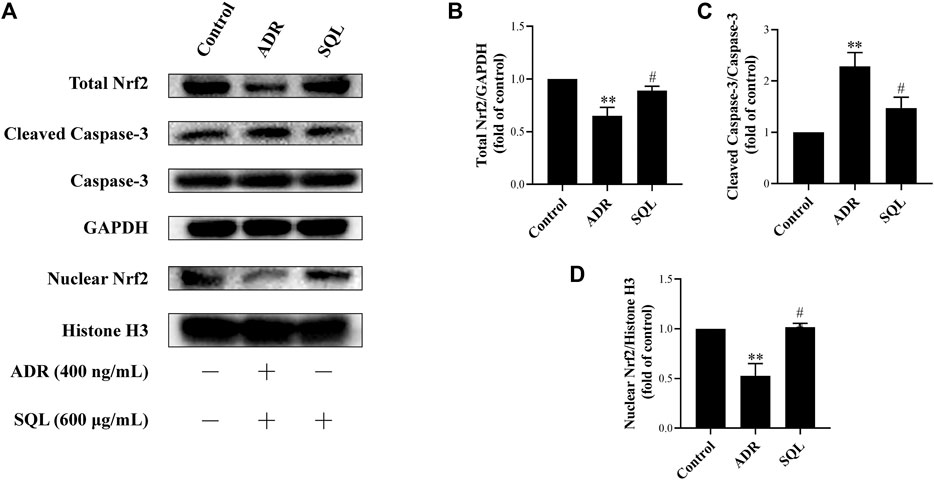
95% of researchers rate our articles as excellent or good
Learn more about the work of our research integrity team to safeguard the quality of each article we publish.
Find out more
CORRECTION article
Front. Pharmacol. , 27 April 2022
Sec. Ethnopharmacology
Volume 13 - 2022 | https://doi.org/10.3389/fphar.2022.905693
 Xiaowan Wang1,2,3,4†
Xiaowan Wang1,2,3,4† Jinchu Liu1,2†
Jinchu Liu1,2† Ruimin Tian1,2,3,4†
Ruimin Tian1,2,3,4† Bidan Zheng1
Bidan Zheng1 Chuang Li1,2,3,4
Chuang Li1,2,3,4 Lihua Huang1,2,3,4
Lihua Huang1,2,3,4 Zhisheng Lu1,2
Zhisheng Lu1,2 Jing Zhang1,4
Jing Zhang1,4 Wei Mao1,2,3,4
Wei Mao1,2,3,4 Bo Liu1,4,5*
Bo Liu1,4,5* Kun Bao1,2,3,4*
Kun Bao1,2,3,4* Peng Xu1,2,3,4*
Peng Xu1,2,3,4*This article is a correction to:
Sanqi Oral Solution Mitigates Proteinuria in Rat Passive Heymann Nephritis and Blocks Podocyte Apoptosis via Nrf2/HO-1 Pathway
A Corrigendum on
Sanqi Oral Solution Mitigates Proteinuria in Rat Passive Heymann Nephritis and Blocks Podocyte Apoptosis via Nrf2/HO-1 Pathway
by Wang, X., Liu, J., Tian, R., Zheng, B., Li, C., Huang, L., Lu, Z., Zhang, J., Mao, W., Liu, B., Bao, K. and Xu, P. (2021). Front. Pharmacol. 12:727874. doi: 10.3389/fphar.2021.727874
In the original article, there was an error. The concentration units of Sanqi oral solution lyophilized power (SQL) and doxorubicin hydrochloride (ADR) in cell experiment were incorrectly written as “600 mg/ml and 400 μg/ml.” It should be “600 μg/ml and 400 ng/ml.”
A correction has been made to Materials and Methods, Podocyte Culture and Treatment, Paragraph 1:
“The conditionally immortalized temperature sensitive mouse podocyte cell line used in this study was established by Professor Peter Mundel (Medical College of Harvard University, Boston, MA, United States). Briefly, podocytes were cultured in RPMI 1640 medium with 10% fetal bovine serum at 33°C in the presence of 10 U/ml recombinant mouse interferon-γ (Sigma, St. Louis, MO, United States). For inducing differentiation, podocytes were thermoshifted to 37°C and cultured in interferon-free medium for 10–14 days. SQL and Trig were dissolved in PBS and storage solutions were stored at −20°C. Podocytes were cultured overnight before experiments and treated with 400 ng/ml ADR with or without 25 μM Nrf2 inhibitor Trig or 600 μg/ml SQL intervention for 24 h.”
In the original article, there was a mistake in the labels of Figures 7, 8 as published. The concentration unit of SQL in cell experiment should be 600 μg/ml, not 600 mg/ml. The corrected Figures 7, 8 appears below.

FIGURE 7. SQL suppressed ADR-injured podocyte apoptosis through activating Nrf2. The protein expressions of total Nrf2, nuclear Nrf2, and Cleaved Caspase-3 were checked by Western blot (A). SQL treatment induced Nrf2 increase (B) and translocation in nucleus (D), and then reducing podocyte apoptosis (C) (n = 3). Data are represented as mean ± SD from independent groups. **p < 0.01 vs. Control group. #p < 0.05 vs. ADR group. ##p < 0.01 vs. ADR group.

FIGURE 8. Role of Nrf2 in ADR-induced podocyte apoptosis and SQL-induced protective effect. Total Nrf2 and Cleaved Caspase-3 were measured by Western blot (A). Trig abrogated lower Nrf2 expression (B) in ADR-injured podocyte led to higher Cleaved Caspase-3 protein expression (C), while SQL cotreatment substantially increased Total Nrf2 protein expression (B) and reduced protein level of Cleaved Caspase-3 (C). Data are represented as mean ± SD from independent groups. *p < 0.05. **p < 0.01.
The authors apologize for this error and state that this does not change the scientific conclusions of the article in any way. The original article has been updated.
All claims expressed in this article are solely those of the authors and do not necessarily represent those of their affiliated organizations, or those of the publisher, the editors and the reviewers. Any product that may be evaluated in this article, or claim that may be made by its manufacturer, is not guaranteed or endorsed by the publisher.
Keywords: Sanqi oral solution, passive Heymann nephritis, podocyte apoptosis, proteinuria, Nrf2/ HO-1 signaling pathway
Citation: Wang X, Liu J, Tian R, Zheng B, Li C, Huang L, Lu Z, Zhang J, Mao W, Liu B, Bao K and Xu P (2022) Corrigendum: Sanqi Oral Solution Mitigates Proteinuria in Rat Passive Heymann Nephritis and Blocks Podocyte Apoptosis via Nrf2/HO-1 Pathway. Front. Pharmacol. 13:905693. doi: 10.3389/fphar.2022.905693
Received: 27 March 2022; Accepted: 05 April 2022;
Published: 27 April 2022.
Edited and reviewed by:
Adolfo Andrade-Cetto, National Autonomous University of Mexico, MexicoCopyright © 2022 Wang, Liu, Tian, Zheng, Li, Huang, Lu, Zhang, Mao, Liu, Bao and Xu. This is an open-access article distributed under the terms of the Creative Commons Attribution License (CC BY). The use, distribution or reproduction in other forums is permitted, provided the original author(s) and the copyright owner(s) are credited and that the original publication in this journal is cited, in accordance with accepted academic practice. No use, distribution or reproduction is permitted which does not comply with these terms.
*Correspondence: Peng Xu, xupeng@gzucm.edu.cn; Kun Bao, baokun@aliyun.com; Bo Liu, doctliu@gzucm.edu.cn
†These authors have contributed equally to this work and share first authorship
Disclaimer: All claims expressed in this article are solely those of the authors and do not necessarily represent those of their affiliated organizations, or those of the publisher, the editors and the reviewers. Any product that may be evaluated in this article or claim that may be made by its manufacturer is not guaranteed or endorsed by the publisher.
Research integrity at Frontiers

Learn more about the work of our research integrity team to safeguard the quality of each article we publish.